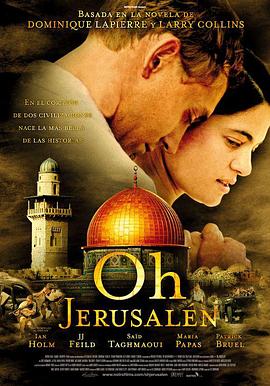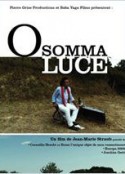
◎简 介 (from VeryCD)
故事背景出现,产生,形成,酿成在二战终结,告终,完结,终止后,联合国就巴勒斯坦分治问题以投票方式决议:英国于1948年8月1日终结,告终,完结,终止在巴勒斯坦的委任统治,两个月后,在巴勒斯坦的土地上建立两个国家,阿拉伯国和犹太国。但是5个阿拉伯联盟国家不同意,在以色列建国次日就发动了对犹太人的战争。电影以犹太人Bobby Goldman和穆斯林Sa?d两个年轻人为主线,重现了以巴分治的历史。他们曾经是好伙伴,好友,挚友,密友,在美国相识,明白,明了,知晓,理解,认知,懂得,为了各自不同的使命回到中东,不同的民族不同的立场让他们在战场上敌对。副线当然少不了爱情,Bobby与Hadassah相识,明白,明了,知晓,理解,认知,懂得,结识,相知,熟识于战争第一天,他们之间的情愫并不渲染得很夸张,能感觉到日益滋长,从眼神和行动中体验,体会,感悟,感悟他们...
(http://lib.verycd.com/2007/04/19/0000147126.html)

转自:http://www.filmlinc.com/nyff/2010/views-from-the-avant-garde-friday-october-1/views-from-the-avant-garde-jean-marie-straub
“The end of paradise on earth.”—Jean-Marie Straub
The 33rd verse and last chant of “paradise” in Dante’s Divine Comedy. The film starts with verse 67, “O somma luce…” and continues to the end. “O Somma luce” recalls the first words uttered by Empedocles in Danièle Huillet and Jean-Marie Straub’s 1987 The Death of Empedocles—“O himmlisch Licht!…” (O heavenly light!). This extract from Hölderlin’s text is also inserted into their 1989 film Cézanne.
“O somma luce” invokes utopia, or better still “u-topos,” Dante, Holderlin, Cézanne… the camera movement, recalling Sisyphus, in the film’s long shots, suggests its difficulty.
In O somma luce, with Giorgio Passerone’s Dante and the verse that concluded the Divine Comedy, we find at the extremity of its possibilities, the almost happy speech of a man who has just left earthly paradise, who tries to fully realize the potential of his nature. Between the two we find the story of the world. The first Jean-Marie Straub film shot in HD.
So singular are the textual working methods of Straub-Huillet, and now Straub on his own, that it is hard to grasp how far reaching they are. Direction is a matter of words and speech, not emotions and action. Nothing happens at the edges, everything is at the core and shines from there alone.
During the rehearsals we sense a slow process by which ingredients (a text, actors, an intuition) progress towards cohesiveness. It is, forgive the comparison, like the kneading of dough. It is the assembling and working of something until it becomes something else… and, in this case, starts to shine. Actually it’s very simple, it’s just a question of opening up to the light material that has been sealed up. Here, the process of kneading is to bring to life and then reveal. The material that is worked on is speech. So it is speech that becomes visible—nothing else. “Logos” comes to the cinema.
The mise en scène of what words exactly?
The process of revealing, “phainestai”; “phainomenon,” the phenomenon, is what take splace, what becomes visible to the eye.
Is “Straubie” Greece?
This mise en scène of speech, which goes beyond a close reading of the chosen text, is truly comes from a distant source.—Barbara Ulrich